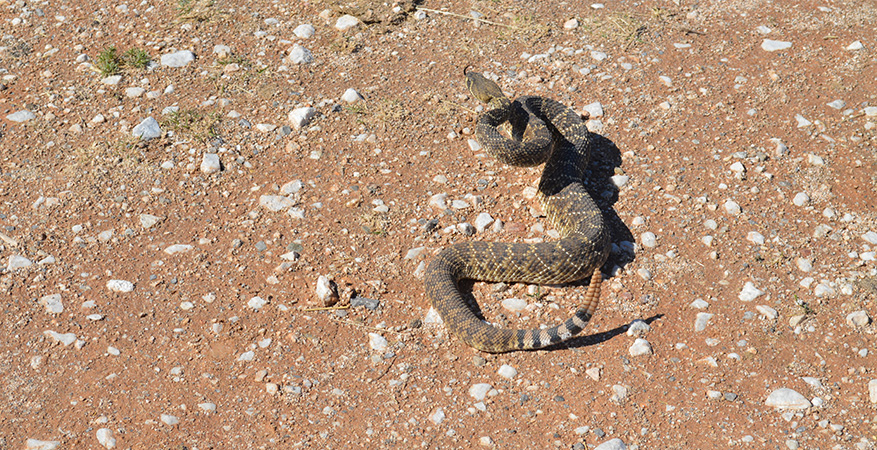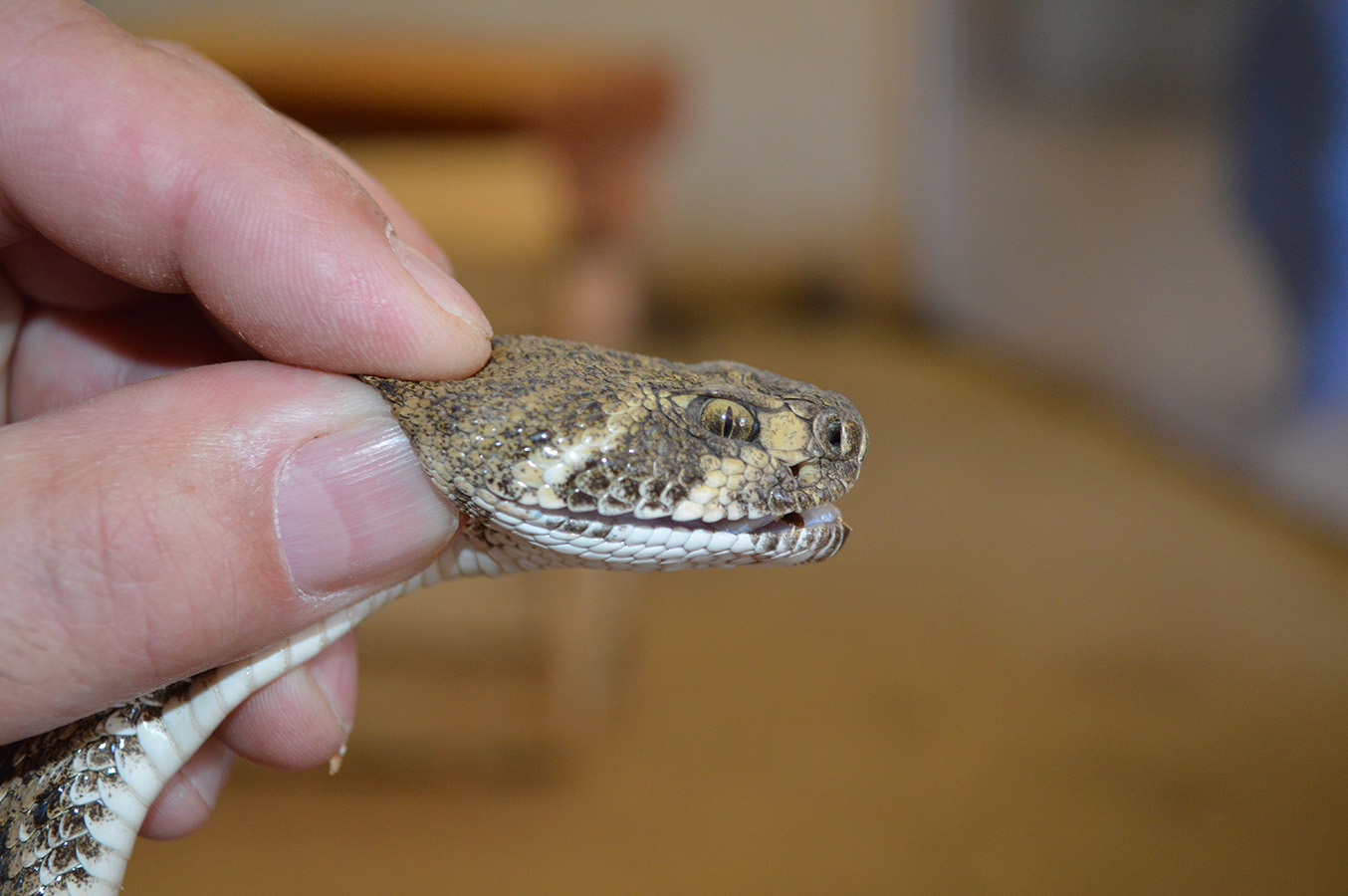
Rattlesnakes play an important role in nature
Thursday, May 3, 2018
It’s a beautiful Friday morning. The thermometer is reading about 70F, there’s a light breeze and just a few clouds casting shadows onto a ranch near Okeene, Oklahoma.
The healthy Brahman cattle are patiently awaiting their breakfast, while the family’s show goats are grazing around the barn under the watchful eye of their giant guard dog. A couple smaller ATVs sit quietly parked nearby as Todd Felder and his trusty four-legged sidekick, Chancho, a Chihuahua mix, carefully pan through cracks and holes in the gypsum scattered throughout the ranch.
The 1998 Oklahoma State University animal science graduate, Felder, is armed with a 5-gallon bucket, a set of basic tongs and his 10-pound companion. He is hunting for snakes; more precisely, western diamondback rattlesnakes. With the barn less than 100 yards away from two known snake dens, and the rancher’s house not too much farther away, Felder is out on a service call.
“This is too close and cramped of quarters for there not to be this interaction between rattlesnakes and landowner, livestock, pets and animals, as well as the kids. When we came out here, he was overrun with them. The first time we hunted this den, we found almost 20 snakes 3-foot or bigger, most of them pushing 5 feet,” Felder said. “They were in the barn. They were on the front porch. He said he needed help, and he sure enough did, and we’re proud to do it for him and proud to do it for anyone that calls.”
The “we” Felder is referring to is the Okeene Diamondback Club, which answers similar calls throughout much of the year. The club was established for this purpose, to help ranch families keep snakes thinned out.

“When the overlap happens, that’s why we’re here,” he said. “We want the kids safe, we want you all safe, we want the dogs, the cats, the cattle and all the livestock safe, and then, they’re going to have their place anyway.”
The snakes are nothing new to the area. Western diamondback rattlesnakes have lived throughout the southwestern United States and Mexico since before Oklahoma statehood. As people began to settle and encroach into the snakes’ habitat, more and more interactions were taking place.
While the vast majority of the more than 40 species of snake found in Oklahoma are nonvenomous, the western diamondback is not one of them and packs quite a punch as one of the most venomous snakes in the state. Venomous animals inject a toxin directly into their prey, as opposed to poisonous animals, which contain a toxin within portions of their bodies that cause harm if ingested or touched.
“Snakes, both venomous and nonvenomous, cause great anxiety in many people and are considered cold-blooded killers,” said Dwayne Elmore, OSU Cooperative Extension wildlife specialist. “They are cold-blooded, of course, but they are usually very docile and will only strike as a last resort, unless you are a rodent or frog.”
Most strikes by snakes on humans are situations in which someone did not see the snake and put their hands somewhere they were not looking or were walking through vegetation and stepped on the snake.
All snakes provide important ecological services, including those that are venomous. Five species of rattlesnake occur in Oklahoma, including the timber, western diamondback, prairie, western massasauga and western pygmy. The key for people is to be able to identify what they are looking at.
“Some of the snakes are hard to distinguish from others,” said Elmore. “But all venomous snakes in Oklahoma are pit vipers, with obvious heat-sensing pits between the eye and nostril, making their heads bulky and somewhat heart shaped from above.”
Most of the rattlesnakes found in the western half of the state are western diamondbacks. Although they can have a color variation, they all have alternating dark and light bands on the tail and interlocking diamond shapes on their backs. Their heads are distinguished by two dark stripes, one of each side of its face, running diagonally from its eyes to its jaws.

“Historically, landowners would go out with guns and just shoot them and bring them back to show everyone in town,” said Felder. “That evolved into the Okeene Rattlesnake Hunt, catching them alive and making an educational festival out of this. We’re still going to clean up these community grounds and do a favor for the landowners, but also educate the masses on the critical need for these snakes.”
During the 79th Annual Okeene Rattlesnake Hunt during the last weekend of April, Felder, who serves as the festival’s pit boss, along with several club members and snake handlers, stood in the snake pit as hoards of people came through to see and learn about the snakes. Protected by four-foot walls, spectators took all the pictures they wanted and asked questions to the Okeene Diamondback Club members.
“They have their place in our ecology to keep that harmonious balance,” Felder said. “They are such a benefit, or they wouldn’t be here, so we want to keep that as ideal and pristine as possible, not only for the landowners and the community, but for the snakes themselves.”
Elmore suggests using some caution when spending time outdoors, and simply walking away from snakes you may encounter, as they are an important part of the ecosystem. Simply leaving a snake to do its job in the landscape is the best way to avoid a bad encounter.
The Oklahoma Department of Wildlife Conservation estimates a rattlesnake eats an average of 21 rodents a year, so if an area was to contain 100 rattlesnakes, that would account for 2,100 rodents falling prey.
“They are nature’s Snickers bar,” said Felder, speaking about mice.
As long as there are mice and other rodents around, rattlesnakes will be close by. Residents of western Oklahoma are hopeful the Okeene Diamondback Club has their phones just as close.
Story by Sean Hubbard
